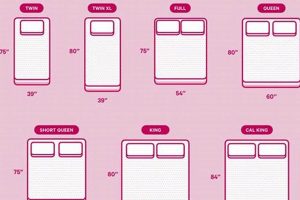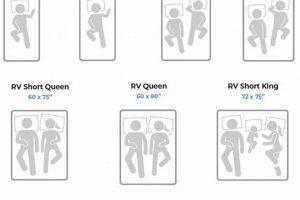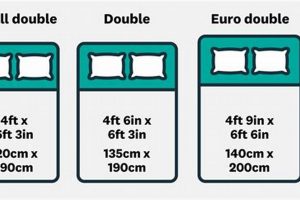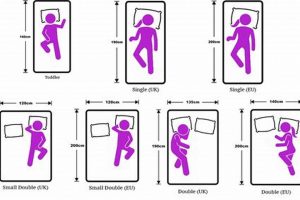The measurements of a queen-size bed setup, encompassing both the sleeping surface and its supporting foundation, are essential considerations for bedroom planning. These figures typically involve a mattress measuring 60 inches in width and 80 inches in length. The box spring, which provides support and elevation, generally mirrors these dimensions to ensure a proper fit and weight distribution.
Accurate knowledge of these measurements is crucial for several reasons. It allows for effective space planning within a bedroom, ensuring the bed fits comfortably without overwhelming the area. Furthermore, understanding the dimensions facilitates the selection of appropriately sized bedding, such as sheets, comforters, and bed frames. Historically, standardized bed sizes have evolved to accommodate varying body types and spatial constraints within domestic architecture.
The subsequent sections will delve into specific aspects of these measurements, including variations in box spring heights, the impact of different mattress types on overall dimensions, and how these figures influence the selection of appropriate bed frames and bedroom furniture.
Essential Considerations for Queen Mattress and Box Spring Dimensions
Selecting the appropriate size sleeping arrangement requires careful attention to measurement. The following guidelines address critical factors related to queen-size mattresses and box springs.
Tip 1: Account for Frame Dimensions: Bed frames often extend beyond the stated mattress size. Measure the frame’s exterior to ensure it fits within the intended bedroom space.
Tip 2: Consider Box Spring Height: Box springs vary in height, influencing the overall bed height. Low-profile options are available for contemporary aesthetics or to accommodate taller mattresses.
Tip 3: Evaluate Room Size: Before purchasing, measure the bedroom’s length and width. Leave sufficient clearance around the bed for comfortable movement and furniture placement.
Tip 4: Check Doorway Widths: Verify that the mattress and box spring can pass through doorways and hallways during delivery. Measure the narrowest points to avoid logistical issues.
Tip 5: Examine Mattress Thickness: Mattress thickness affects the overall bed height and can impact accessibility for individuals with mobility limitations.
Tip 6: Coordinate with Bedding: Confirm that the chosen sheets, comforters, and other bedding items are appropriately sized for the queen mattress dimensions.
Tip 7: Factor in Weight Capacity: Box springs have weight limits. Select a model that can adequately support the combined weight of the mattress and sleepers.
Adhering to these guidelines ensures a comfortable and functional sleep environment. Precise planning prevents unforeseen difficulties related to space constraints and compatibility issues.
The next section addresses common challenges associated with delivery and setup of queen-size mattresses and box springs.
1. Width
The width of a queen mattress, standardized at 60 inches, represents a critical dimension directly influencing its suitability for accommodating two adults. This measurement dictates the available personal space for each individual sharing the bed, affecting sleep quality and comfort. Inadequate width may result in restricted movement and sleep disturbances, particularly for individuals accustomed to larger sleeping surfaces. A narrower sleeping arrangement, such as a full-size mattress, provides insufficient space for comfortable shared occupancy, highlighting the queen’s 60-inch width as a necessary compromise between space efficiency and individual comfort.
The box spring, designed to support the mattress, typically mirrors this 60-inch width to ensure proper weight distribution and prevent sagging. A mismatch in width between the mattress and box spring can lead to uneven support, premature wear and tear, and compromised sleep posture. For example, placing a queen mattress on a box spring designed for a full-size bed would result in overhang and inadequate support along the edges, drastically reducing mattress lifespan and potentially causing discomfort or injury. Similarly, the width influences bedding selection, requiring queen-size sheets and comforters to properly fit and provide adequate coverage.
In summary, the 60-inch width is an integral component of the queen mattress and box spring dimensions, directly impacting sleep quality, support, and compatibility with related bedding and furniture. Accurate adherence to this standard ensures optimal performance, longevity, and overall comfort. Variations or deviations from this specified width can introduce instability and reduce the functionality of the entire sleep system.
2. Length
The length dimension of a queen mattress, standardized at 80 inches, is a critical determinant of overall sleeping comfort, particularly for individuals of above-average height. This measurement dictates the available space from head to toe, directly impacting the ability to stretch out fully and maintain a comfortable sleep posture. Insufficient length can lead to discomfort, restricted movement, and potential sleep disturbances. For instance, an individual exceeding 6 feet in height may find a full-size bed (typically 75 inches long) inadequate, while the queen’s 80-inch length offers a more suitable and comfortable alternative.
The corresponding box spring, an integral component of the support system, maintains the same 80-inch length to ensure consistent weight distribution and prevent mattress sagging. A mismatch in length between the mattress and box spring creates an uneven surface, reducing support and potentially shortening the mattress lifespan. This consistency in length is critical, especially given the queen mattress’s wider profile. Further considerations include bed frames, which must accommodate the combined length of the mattress and box spring. Bedding, such as sheets and comforters, is also designed to align with this standard length. A deviation from this standard can result in ill-fitting linens and an overall compromised sleep experience.
In conclusion, the 80-inch length standard for queen mattresses and box springs serves a fundamental purpose in ensuring comfortable and supportive sleep. Understanding this dimensional requirement is essential for selecting the appropriate bed and bedding to maximize rest quality and prevent discomfort. Challenges in finding bedding or bed frames that perfectly align with this standard length may arise due to manufacturing variations, highlighting the importance of careful measurement and product assessment prior to purchase.
3. Height
The height dimension, as it relates to queen mattress and box spring combinations, influences accessibility, aesthetic integration, and overall comfort. The combined height dictates the ease with which individuals can enter and exit the bed, an especially important consideration for those with mobility limitations. Moreover, the height contributes significantly to the bed’s visual presence within the room. A low-profile combination can create a modern, minimalist aesthetic, while a taller setup may project a more traditional or luxurious feel. The choice of height also affects the perceived space within the room, with lower profiles often making smaller rooms appear larger. For example, a thick mattress paired with a standard box spring can result in a bed height exceeding 30 inches, which may present challenges for shorter individuals or those with joint pain.
Variations in height arise from several factors, including the thickness of the mattress itself and the construction of the box spring. Mattress thickness can range from a slim 8 inches to a substantial 16 inches or more, directly impacting the overall height. Box springs are available in standard and low-profile designs, offering further customization of the bed’s vertical dimension. The height of the bed frame also contributes, as some frames incorporate legs or platforms that raise the mattress and box spring further from the floor. The selection of appropriate bedding, such as bed skirts, must account for the combined height of the mattress, box spring, and frame. Failure to consider these factors can lead to a disproportionate or visually unappealing result.
Understanding the height dimension of a queen mattress and box spring is therefore essential for optimizing both functionality and aesthetics. This understanding allows for informed decisions that enhance comfort, accessibility, and the overall visual harmony of the bedroom. Challenges may arise in achieving the desired height due to limited product availability or inconsistencies in dimensional specifications, necessitating careful measurement and comparison prior to purchase. The interplay between height and other dimensional considerations, such as width and length, highlights the need for a holistic approach to bedroom planning.
4. Frame Overhang
Frame overhang, the extent to which a bed frame exceeds the specified queen mattress and box spring dimensions, is a critical factor influencing both aesthetics and functionality. Excessive overhang can pose safety hazards, creating protruding edges that increase the risk of accidental collisions. Conversely, insufficient overhang may compromise the intended visual appeal of the bed frame, making the mattress and box spring appear disproportionately large. For example, a platform bed with a minimalist design may feature a slight overhang of only a few inches, emphasizing clean lines and a floating aesthetic. In contrast, an ornate, traditional bed frame could incorporate a more substantial overhang, allowing for decorative side rails and footboards that complement the mattress and box spring.
The practical significance of understanding frame overhang lies in its impact on bedroom space planning and furniture placement. Accurate measurements of the entire bed assembly, including the frame overhang, are essential for ensuring sufficient clearance around the bed and preventing obstruction of doorways or walkways. This is particularly relevant in smaller bedrooms where maximizing usable space is a priority. Consider the scenario of a bedroom with limited square footage: a bed frame with a significant overhang could impede movement and create a cramped environment. Moreover, frame overhang can influence the selection of bedside tables and other bedroom furniture, requiring careful consideration of dimensions to achieve a balanced and harmonious layout.
In conclusion, frame overhang represents a crucial dimensional element that extends beyond the standard queen mattress and box spring dimensions. Its careful consideration is essential for ensuring safety, optimizing aesthetics, and facilitating effective space planning. Challenges in accounting for frame overhang may arise from inconsistencies in manufacturing standards or the absence of detailed product specifications. Therefore, precise measurement and a thorough understanding of the intended visual and functional outcomes are indispensable when selecting a bed frame.
5. Support Structure
The support structure beneath a queen mattress directly correlates with its dimensions and overall performance. A properly sized and constructed support structure, typically a box spring or platform, ensures uniform weight distribution across the 60-inch width and 80-inch length of the mattress. Inadequate support leads to localized stress, premature wear, and potential sagging, reducing the mattress’s lifespan and compromising sleep quality. For example, placing a queen mattress on a foundation designed for a smaller full-size bed results in unsupported edges that compress and degrade more rapidly than the center of the mattress. This uneven wear creates an unlevel sleeping surface and diminishes the intended comfort and support characteristics of the mattress.
Variations in support structures, such as traditional coil box springs versus solid platform bases, influence the perceived firmness and responsiveness of the queen mattress. Coil box springs offer a degree of flex, potentially enhancing the conforming properties of the mattress, while solid platforms provide a more rigid and stable base. The choice of support structure should align with the mattress type and the sleeper’s preferences. Furthermore, understanding the weight capacity of the support structure is essential. Exceeding this capacity can compromise the structural integrity of the foundation, leading to collapse or deformation and negatively impacting the mattress above. Real-world scenarios often involve damage claims due to mattress sagging caused by an inadequate or damaged support structure, underscoring the financial implications of proper selection and maintenance.
In conclusion, the support structure is an inextricable component of the overall queen mattress and box spring system. Its dimensions and construction must be appropriately matched to the mattress to ensure optimal support, longevity, and sleeping comfort. Ignoring the crucial link between these elements leads to compromised performance and potentially costly replacements. Challenges often arise in assessing the compatibility and condition of existing support structures, emphasizing the importance of professional consultation or detailed product specifications when purchasing a new mattress.
6. Total Footprint
The total footprint, representing the overall area occupied by a queen mattress and box spring within a bedroom, is directly determined by the individual dimensions of these components and their associated frame. The standard queen mattress size of 60 inches in width and 80 inches in length serves as the base measurement, but the addition of a box spring and a bed frame invariably increases this overall area. This expansion is critical to consider during bedroom layout planning, as it dictates the available space for other furniture and movement. For example, a bedroom with a limited square footage requires careful assessment of the total footprint to prevent overcrowding and ensure functional access to all areas of the room.
The practical significance of accurately calculating the total footprint extends to considerations beyond mere spatial arrangement. It influences the selection of appropriately sized rugs, the placement of lighting fixtures, and the overall aesthetic balance of the room. An underestimation of the total footprint can lead to ill-fitting accessories and a compromised visual harmony. Conversely, an overestimation might result in an underutilization of available space. Scenarios involving complex bed frames, such as those with extended headboards or footboards, necessitate precise measurements to determine the true total footprint. Ignoring these elements can lead to miscalculations and subsequent design challenges.
In summary, the total footprint is a critical derived measurement directly linked to the queen mattress and box spring dimensions, incorporating frame considerations. Its accurate assessment is paramount for effective space planning, harmonious aesthetic integration, and overall functionality within the bedroom. Challenges in determining the precise total footprint often stem from variations in bed frame designs and a lack of readily available dimensional specifications. Therefore, a meticulous approach, involving careful measurement and consideration of all contributing elements, is essential for informed decision-making.
Frequently Asked Questions
The following questions address common inquiries regarding queen mattress and box spring dimensions, providing clarity on key considerations for selection and setup.
Question 1: What are the standard measurements of a queen mattress?
A queen mattress typically measures 60 inches in width and 80 inches in length. Height can vary depending on the mattress type and construction.
Question 2: What are the typical dimensions of a queen-size box spring?
A queen box spring generally mirrors the mattress dimensions, measuring 60 inches wide and 80 inches long. Height varies, with options for standard and low-profile designs.
Question 3: How do bed frame dimensions relate to queen mattress and box spring dimensions?
Bed frames are often slightly larger than the combined mattress and box spring dimensions to accommodate the bedding and provide a finished look. The frame’s overall dimensions should be considered for room planning.
Question 4: Is it necessary to use a box spring with a queen mattress?
While a box spring provides support and elevates the mattress, it is not always necessary. Platform beds and other support systems can eliminate the need for a box spring, provided they offer adequate support.
Question 5: How do queen mattress and box spring dimensions impact bedroom space planning?
The combined dimensions of the mattress, box spring, and frame dictate the bed’s total footprint. This is a critical factor in determining furniture placement and ensuring sufficient space for movement within the bedroom.
Question 6: What are the potential consequences of using an incorrectly sized box spring for a queen mattress?
Using an incorrectly sized box spring can compromise the mattress’s support, leading to premature wear, sagging, and a reduction in overall comfort and lifespan.
Understanding these dimensional considerations is essential for selecting a queen mattress and box spring that fits both the physical space and individual needs.
The subsequent section explores best practices for ensuring proper fit and support with queen mattress and box spring combinations.
Queen Mattress and Box Spring Dimensions
This exploration has underscored the critical importance of understanding queen mattress and box spring dimensions in ensuring both comfort and practicality. The various dimensional aspects, including width, length, height, frame overhang, support structure, and total footprint, each play a significant role in the overall functionality and aesthetic integration within a bedroom. Accurate measurements and careful consideration of these factors are essential for effective space planning and the selection of compatible bedding and furniture.
The longevity and performance of a queen mattress are intrinsically linked to the suitability of its supporting foundation. Disregard for the dimensional requirements can lead to compromised support, accelerated wear, and a diminished sleep experience. Therefore, diligent assessment and informed decision-making regarding queen mattress and box spring dimensions are paramount for optimizing both comfort and long-term value. A failure to address these fundamental considerations can result in avoidable expense and prolonged dissatisfaction.







